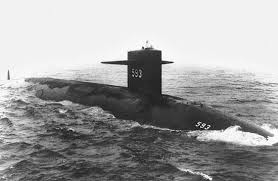In 1963, the United States Navy experienced a tragic and devastating loss with the sinking of the USS Thresher (SSN-593), a nuclear-powered submarine, during a routine deep-diving test off the coast of New England. The loss of the USS Thresher marked one of the deadliest submarine disasters in U.S. naval history and sent shockwaves through the military and the nation as a whole. The sinking of the USS Thresher in 1963 highlighted the risks and challenges of operating advanced nuclear submarines and underscored the importance of safety protocols and rigorous training in ensuring the well-being of sailors and the integrity of the naval fleet. The USS Thresher was a state-of-the-art nuclear-powered attack submarine commissioned in 1961, designed to operate at greater depths and speeds than conventional submarines of its time. On April 10, 1963, the USS Thresher set out on a deep-diving test mission in the North Atlantic Ocean, accompanied by the submarine rescue ship USS Skylark. As the submarine descended to test its maximum operating depth, a series of catastrophic events unfolded, leading to the sudden loss of communication and propulsion systems on board. The exact cause of the USS Thresher's sinking remains uncertain, but it is believed that a combination of mechanical failure, human error, and design flaws contributed to the disaster. The submarine's crew and engineers on board struggled to regain control of the vessel as it descended below crush depth, experiencing extreme pressure and structural failure. Despite their best efforts to save the submarine, the USS Thresher ultimately imploded and sank to the ocean floor, claiming the lives of all 129 crew members on board. The loss of the USS Thresher sent shockwaves through the U.S. Navy and the nation, prompting a thorough investigation into the causes of the disaster and a reevaluation of safety procedures and protocols for nuclear submarines. The tragedy highlighted the inherent risks and complexities of operating advanced submarines in deep-sea environments and underscored the need for improved training, maintenance, and emergency response capabilities to prevent future accidents. In the aftermath of the USS Thresher disaster, the U.S. Navy implemented a series of reforms and safety measures to enhance the survivability and operational capabilities of its nuclear submarine fleet. These included improved training programs for submarine crews, enhanced safety protocols for deep-diving operations, and the development of advanced rescue and recovery systems to respond to emergencies at sea. The lessons learned from the USS Thresher tragedy helped shape the future of submarine operations and safety standards in the U.S. Navy, ensuring that similar disasters could be prevented in the future. The sinking of the USS Thresher in 1963 remains a somber reminder of the dangers and sacrifices inherent in military service and naval operations. The loss of 129 lives aboard the submarine served as a poignant tribute to the bravery and dedication of the sailors who perished in the line of duty, as well as a call to action for the Navy to prioritize safety, training, and preparedness in its operations. The legacy of the USS Thresher lives on in the ongoing commitment of the U.S. Navy to honor the memory of those lost and to uphold the highest standards of excellence and professionalism in its mission to protect and defend the nation's interests at sea.
10 april 1963 U.S.A. USS Thresher
